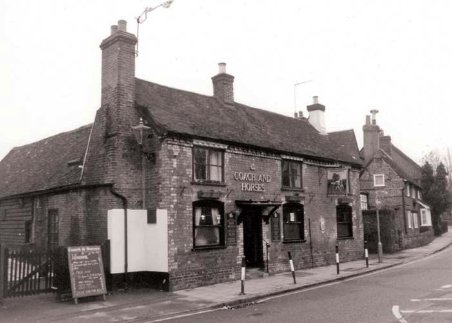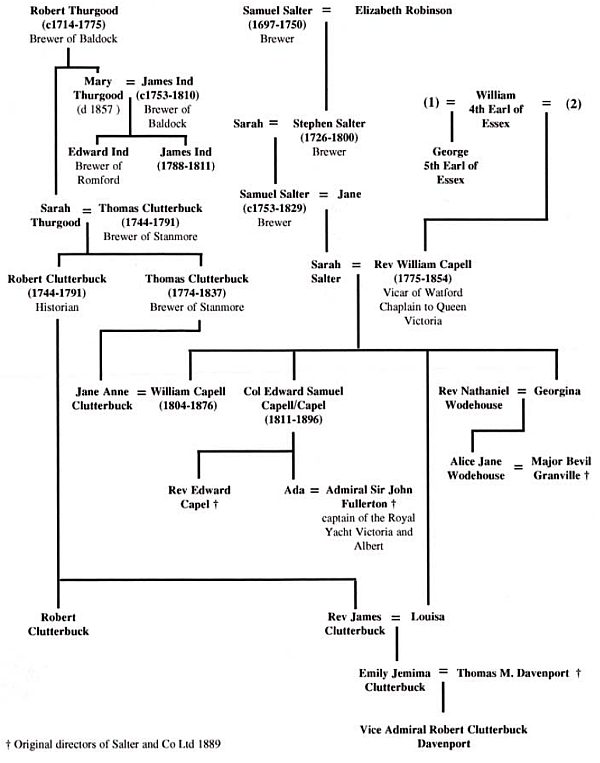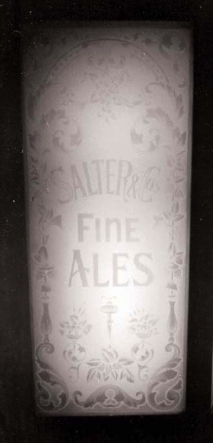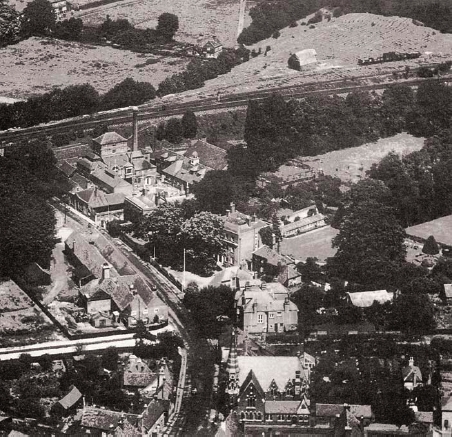
Copyright © 2005 the Brewery History Society
|
Journal Home > Archive > Issue Contents > Brew. Hist., 119, pp. 32-40 |
Salter's of Rickmansworth |
by Martyn Cornell |
The early days of any business more than a century old are always difficult to trace. The founders were too busy trying to make money to have time to record for history how and when they began their enterprise. Although Salter's brewery provided beer to dozens of pubs in and around Rickmansvvorth for more than 170 years, the firm's beginnings are still indistinct.
It has been claimed for the Salters of Rickmansworth that they were members of a family which had been 'brewing since Commonwealth times.' 1 A James Salter of Ware was indicted for keeping an unlicensed alehouse in 1661, 2 although whether he was any relation is unknown. The first Salter to turn up in Rickmansworth was Samuel Salter, born about 1696, who married Elizabeth Robinson in the town's church in 1724. 4 By 1727 he was paying rates of 1/- on property in the town, the sort of sum a cottage would cost. 5
When Samuel Salter began brewing seems impossible to tell precisely. But in 1741, when he was 46, he appears to have bought the Coach and Horses in Rickmansworth, and the same year his rates had risen to 4/-, a strong indication that a change of occupation had taken place at wherever he was now dwelling. 1
The Coach and Horses is first known of for sure in 1722, 6 though, the building's foundations may be as old as the end of the 16th century. 3 If William Branch Johnson is right in Hertfordshire Inns, then Salter's brewery grew up alongside the pub, and may originally have been the pub's own brewhouse. In 1762, Johnson says, the Coach and Horses was 'incorporated into the adjoining buildings of the Salter brewery as the brewery tap.’
If this is so, however, then as the brewery prospered it eventually outgrew its site by the Coach and Horses and was rebuilt further out of town and on the other side of the road, leaving the pub behind.
In June 1750, Samuel Salter had died aged 53. He had evidently been ill for some time, since his memorial in Rickmansworth churchyard reads, poignantly: ‘While in this earth I did remain, my latter days was (sic) full of pain.’
The following year, 1751, Samuel's son Stephen was assessed for twice the rates his father had been paying, charged specifically for the first time against a brewery. 5 Within a few years the brewery was acquiring tied houses outside Rickmansworth in 1759 Stephen Salter bought the Chequers (now the Coach and Horses) in Ickenham, Middlesex, 7 in 1767 he added the Rose and Crown, Mill End, and in 1770 the Bell, Pinner. The Feathers in Uxbridge was bought in 1772, the White Hart, Bushey in 1782, the Blue Boar, Uxbridge (later the Metropolitan) in 1783, the Vine, Hillingdon was acquired the same year, and the Red Lion, Elstree in 1786.6 & 7
|
|
 |
|
|
By 1789 Stephen Salter was 63, and doubtless much of the running of the brewery was already in the hands of his only son, Samuel Salter II. That year Stephen handed over ownership of at least one of his pubs, the Feathers. Uxbridge, to Samuel, his 'heir apparent' 'in consideration of the paternal love and affection which he has born unto his son Samuel, and also for the better maintenance and support, livelihood and preferment of the said Samuel, and for divers other good causes.' 8
Stephen Salter died on New Year's Day 1800, aged 74. 'sincerely regretted by his family and numerous friends.' 9 By this time Salter's brewery controlled at least 18 tied houses, and probably quite a few more. The income they provided enabled Samuel Salter II to move in more exalted circles than his cottager grandfather would have. In June 1802 Samuel's only daughter, named Sarah after her grandmother, married the Reverend William Capell, half-brother to the Earl of Essex and later chaplain to Queen Victoria.
Around the beginning of the nineteenth century several branches of the Grand Union Canal were built at Rickmansworth. 'The first left immediately below Batchworth lock and ran for nearly 540yd up to a new wharf in Rickmansworth. It was a canalisation of the river Chess through one lock and was built for Salters brewery, which was sited close to the new wharf. Opened in 1804, it was often known as Salters Cut, and its main traffic was beer in barrels to Uxbridge, with the empty barrels in return. Coal and general goods were also `brought to the town wharf.' 22
Samuel Salter was still apparently running the brewery on his own in 1822, when he was 69, but by 1827 he had taken a partner, Job Woodman. 10 Samuel died in June 1829 (his widow Jane, 14 years his junior, was to live in one of the houses next door to the brewery until her death in 1843). Although Woodman carried on running the concern day to day, ultimate control was placed in two trustees, Thomas Fellowes, a Rickmansworth land-owner, and William Capell. This is presumably the William Capell who was Samuel's grandson, Sarah's eldest son, then aged 25. 1 (Capell married Jane Anne Clutterbuck, whose family ran a brewery at Stanmore in Middlesex, and through her he was linked by marriage to the Thurgoods, brewers of Baldock and the Inds, brewers of Romford.)
Samuel Salter's will had as one of its provisions the supply of a free cask of beer to be left in the brewhouse yard every day for passers-by to help themselves. This was a practice followed by at least three other Hertfordshire brewers, at Baldock, Hatfield and Hoddesdon. But the crowds that eventually turned up each morning to drink Salter's free beer forced the company to move the cask out of the brewery itself. First it was left every morning at a point where, in later years, the railway bridge was built alongside the brewery. Later the site of the daily free beer was moved further out of town, by the company's maltings on the way to Croxley Green. 11
In 1837 the brewery, still known as Salter and Woodman, called in a surveyor to report on the state of the pubs in the tied estate. The survey shows that the Rickmansworth brewery had 76 tied houses in all, from St Albans to Ruislip and Edgware to Amersham. There were 13 Salter-owned inns, pubs and beerhouses in and around Rickmansworth, and no fewer than 11 in Chesharn, a strong hint that Salter's at some time took over another brewery there. 12
|
|
 |
|
|
Job Woodman, then 56, was still at the brewery in 184l, when the census returns also showed 10 men working as brewer's labourers in the town, and two coopers. By 1845 the title of the company had reverted back to Salter and Co. In 1851 Richard Reece, the former head brewer at Hawkes's brewery in Bishops Stortford, was head brewer at Salter's.
The tradition of the free 36-gallon cask of beer being left out every day for passersby was still carried out in the 1850s. The Illustrated London News carried a report, and a picture of the scene, in its issue of 11 October 1851, though the disappointed ILN reporter said that by the time he got to the barrel 'it had run to its last legs.’ But by 1856/7 the rowdiness of the people who gathered to drink the free beer finally forced the brewery to bring the tradition to a close. Writing 40 years later, John Doggett said that he had seen as many as 100 people gathered round the cask at a time. The crowd would empty it in less than an hour, and then begin fighting. 11
Thomas Fellowes, the non-family trustee of the brewery, died at his home, Money Hill House, Rickmansworth, in January 1858. 13 His responsibilities as a trustee eventually passed to his sons Harvey Winson Fellowes, a solicitor, and Herbert William Fellowes. 14 By 1861 Herbert William, then 32, was living in the brewery house, and running the brewery, a job he held until at least 1881. The town had 16 'brewer's labourers' listed in the 1861 census, as well as a brewer's clerk, and even an 'engine driver in a brewery' this would have been a stationary engine powering pumps and pulleys. Salter's, it appears, now had steam power.
One of those brewery workers was Edward Tibbles, who died in January 1874, aged 62. Even at that age, the Watford Observer reported, Tibbles had still put in 'upwards of 50 years' employment with Salter's.
In 1875 Herbert Fellowes' neighbour was Mary Ann Evans, better known as the author George Eliot, who was staying at The Elms, next door to the brewery. During her stay, the novelist wrote to a friend that she 'preferred a county where I don't make bad friends by having to see one public house to every six dwellings, which is literally the case in many spots around us. My gall rises at the rich brewers, in Parliament and out of it, who plant their poison shops for the sake of their million-making trade, while probably their families are figured somewhere as refined philanthropists and ritualists.’ 1 One wonders if she meant the Fellowes, or the descendants of Samuel Salter, or both.
In 1887, the year the Metropolitan Railway came right alongside the brewery, it was announced that Salter's was to erect a new 40-quarter plant, as well as enlarge the existing premises, all to the design of William Bradford, one of the most prolific brewery architects of the time.15 (His brewery commissions in Hertfordshire included one for Wells of Watford and another for the Fox Brewery, Bishops Stortford). Bradford's design was a typical five-storey Victorian tower brewery, with a boilerhouse and a tall chimney. There was also a two-storey maltings facing the road, while on the opposite side.
'A layout of the Brewery Estate drawn on linen by Swannell & Sly on 6th February, 1905, shows a very large store area fronting High Street. Across the back of the premises and taking up almost the entire width of the site were extensive stables with bays for twenty horses, and also a food store [complete with a clock tower topped with a cupola]. Situated to the right of the yard entrance was Brewery House, where the Salter family had lived.’23
Two years later, on December 24th 1889, Salter and Co was registered as a limited company, the first big brewery in Hertfordshire to turn itself into a limited concern.16 Three of the first four directors, Thomas Davenport, Major Bevil Granville and Captain John Fullerton, were married to grand-daughters of Sarah Salter. The fourth was one of Sarah's grandsons, the Reverend Edward Capel (the Capells dropped one 'I' from their name in the 1870s). Their connections reflected the way Stephen Salter's offspring had risen in the world the Granvilles were related, through Mrs Granville, to the Earls of Kimberley, while Captain Fullerton, later Admiral Sir John, eventually became extra-room-in-waiting to Edward VII and captain of the Royal Yacht Victoria and Albert.
|
|
 |
|
|
Shortly after the brewery became a limited company it issued a very attractive colour-printed price list with an artist's offices built on the site. impression of the brewery, a drawing of a typical 'covered wagon' brewer's dray, and the brewery monogram [reproduced on the front cover of this issue]. It showed the brewery producing a range of nine draught beers, normal for the time, with the weakest, table beer, at ten (old) pence a gallon, and the two dearest, East India Pale Ale and XXXX strong ale, at one shilling and eightpence a gallon. The standard shilling-a-gallon beers were BB light pale ale, XX mild ale and porter.
Salter's produced two types of bottled beer, pale ale (`sparkling, no sediment') and double stout, both at two shillings and sixpence per dozen pints, 'not less than three dozen pints supplied.’
By 1890 the brewery manager was James Scully,16 then in his late 30s, who was to continue as manager until the brewery closed more than three decades later. At Christmas 1895, the Middlesex Advertiser reported, Salter's gave each of the brewery workers an extra week's wages, in addition to the usual Christmas gifts, 'to show their appreciation of the share of their men in the prosperous year through which the company had just passed.' The occasion was marked, the newspaper said, 'by an appropriated speech on the part of the manager, Mr Scully, which was received with loud applause'.18
Salter's owned or leased 47 tied houses in Hertfordshire in the 1902 licensing magistrates' survey of the county, with only three of them beerhouses easily the lowest proportion of beerhouses to fullylicensed pubs of any of the county's brewers, and an indication that it had built up the bulk of its tied estate before the passing of the 1830 Beer House Act. It controlled 19 of the nearly 50 pubs and beerhouses in and around Rickmansworth in 1905, though four of its pubs were among the 11 in the district closed by magistrates as 'surplus' in 1911.19
With these and other losses, by 1923 Salter's tied estate numbered 77, almost exactly the same number as in 1837. Its range of bottled beers had grown to include dinner ale and ordinary stout. But just before Christmas 1923, James Scully, still the brewery manager, died aged 70.20 Within weeks Salter's directors had arranged the sale of the brewery and all its tied houses to the Cannon Brewery Company Ltd of St John Street, in the City of London.
The omnibus conveyance which handed over the property to the Cannon Brewery was signed on the last day of March 1924.7 A few months later the entire Rickmansworth brewery plant was put up for sale. It was described in the sale announcement as a 25-quarter brewery (meaning it could mash around 3½ tons of malt at a time), though the two mash tuns were of 27 quarters and nine quarters capacity. The copper, however, was a 98-barrel one. Other equipment included steam and gas engines, a solid aluminium fermenting round, oak and deal fermenting rounds and squares, bottling equipment, and an 'almost new' 50-quarter malting plant.21
The brewery site was bought by a local firm of boatbuilders, Walkers. Two years later a group of local businessmen opened a cinema in part of the brewery buildings. Other parts of the site were used by a tennis racquet maker and, later a fertiliser firm. Eventually in 1972 the brewery buildings were demolished and offices built on the site.
|
|
 |
|
|
The Coach and Horses, meanwhile went with all Salter's other pubs to Taylor Walker after that company took over the Cannon Brewery in 1930. When Ind Coope acquired Taylor Walker in 1959 it sold a batch of six pubs pubs around Rickmansworth to Wells and Winch, the Biggleswade brewer, to try to reduce its monopoly of pubs in South Hertfordshire. Two years later Wells and Winch became part of Greene King of Bury St Edmunds, so that Samuel Salter's old brewery tap now carries the insignia of a brewer from Suffolk.
|
1 |
Geoffrey Cornwall, Rickmansworth Historian no. 9, Spring, 1965, pp 204-8 |
|
2 |
Helen Poole, Here for the Beer: A gazetteer of the Brewers of Hertfordshire. 1984 p41 |
|
3 |
V Burden Historic Chiltern Inns, 1974 p 92 |
|
4 |
Rickmansworth parish registers |
|
5 |
Geoffrey Cornwall, Rickmansworth Historian no. 25, Spring 1973, pp 625-6 |
|
6 |
W. Branch Johnson, Hertfordshire Inns part 2, pub Herts Countryside 1963 |
|
7 |
Ind Coope Taylor Walker property records |
|
8 |
Greater London Record Office Ace 538/2nd dep/2666. Geoffrey Cornwall in the Rickmansworth Historian calls the Samuel Salter who inherited the brewery Stephen's nephew. It is not impossible Stephen had a nephew called Samuel as well as a son called Samuel, but I have found no evidence for this. |
|
9 |
This is the date which appears on a memorial in Rickmansworth Parish Church recorded by John Cussans in his History of Hertfordshire. Geoffrey Cornwall, however, several times gives the date of 11 February 1795 for Stephen Salter's death, though there is no matching record in the Rickmansworth parish registers. There was another Stephen Salter, of Watford, a member of the Watford Baptist meeting house, who was a close contemporary and who, by coincidence, also married a Sarah and had a son called Samuel. He is sometimes confused with the Rickmansworth Stephen Salter. His will, listed in the consistory court of London records at the Greater London record office, DL/C/374, was made in 1804, and in it he asked to be buried in the Watford Baptist Meeting House. |
|
10 |
Pigot's Directories of Hertfordshire 1822 and 1827. The latter actually calls the brewery 'Salter and Goodman', evidently a typographical error. |
|
11 |
Herts Advertiser 10 October 1896 |
|
12 |
The notebook containing the report, now in Watford museum, does not actually name the owner of the pubs surveyed, but internal evidence shows it was clearly Salter's brewery estate, and probably a complete survey. |
|
13 |
Cussans, History of Hertfordshire |
|
14 |
Groves, Longman and Wood, From the Wheatsheaf to the Windmill, pub. Bushey Museum Trust 1984 |
|
15 |
Brewers' Journal June 1887 |
|
16 |
Brewers' Journal January 1890 |
|
17 |
Kelly's Post Office Directory of Hertfordshire, 1890 |
|
18 |
Middlesex Advertiser January 1 1896 |
|
19 |
Annotated copy of Herts licensing magistrates' survey 1905, in possession of McMullen and Co Ltd |
|
20 |
Middlesex Advertiser December 21 1923. His funeral was at the Catholic Church in Rickmansworth |
|
21 |
Middlesex Advertiser 18 July 1921 |
|
22 |
Alan H Faulkner, The Grand Junction Canal 1993 p66 |
|
23 |
Anthony J Waker, Walkers' of Ricky: A History of WH Walker & Brothers Limited of Rickmansworth, Hertfordshire 1991 WH Walker & Brothers Limited p54 |
Martyn Cornell wishes to acknowledge the invaluable help of David Dines in preparing this history.